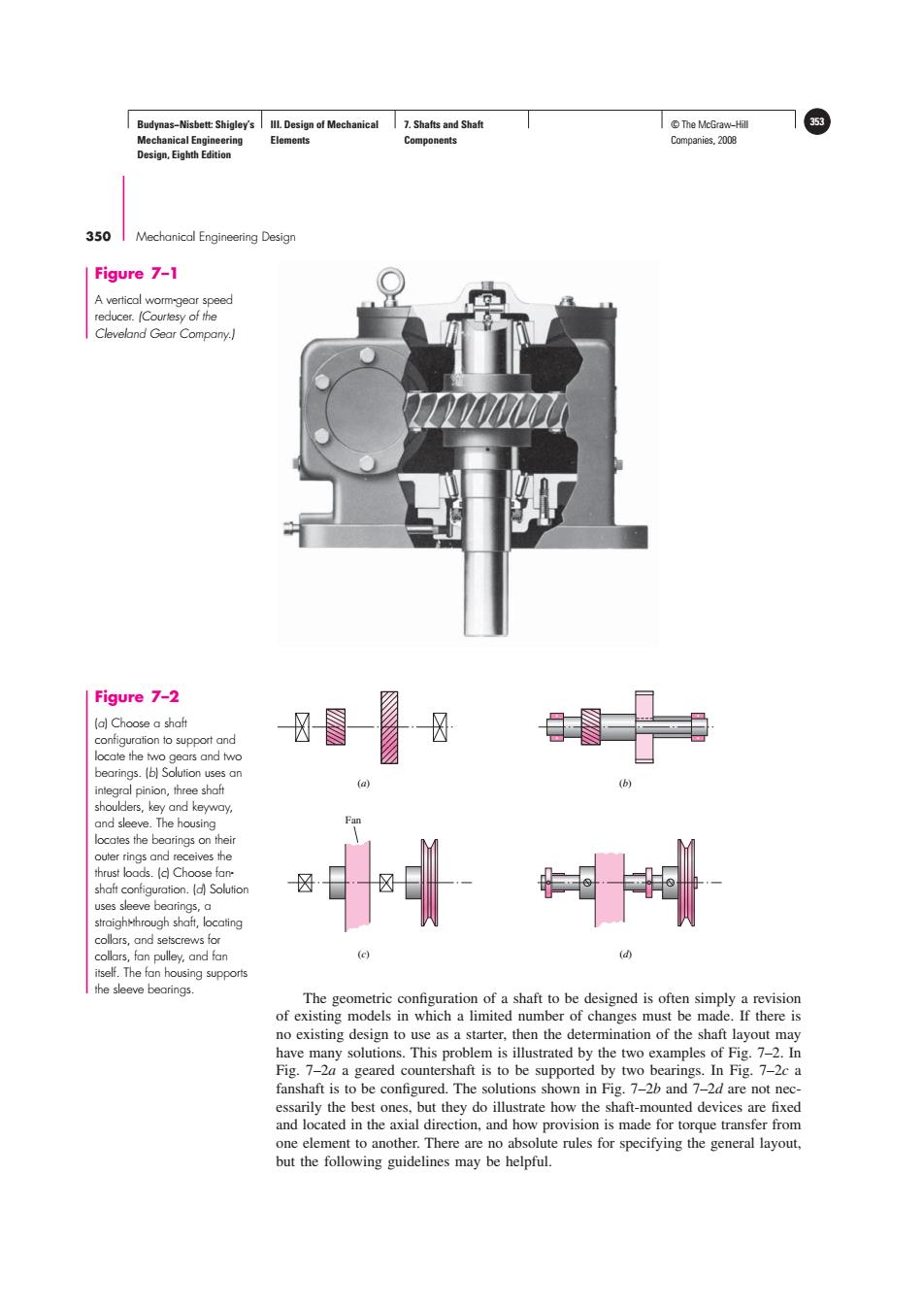正在加载图片...

Budynas-Nisbett:Shigley's Ill.Design of Mechanical 7.Shafts and Shaft T©The McGraw-Hil 353 Mechanical Engineering Elements Components Companies,2008 Design,Eighth Edition 350 Mechanical Engineering Design Figure 7-1 A vertical wormgear speed reducer.[Courtesy of the Cleveland Gear Company.] Figure 7-2 (a)Choose a shaft configuration to support and locate the two gears and two bearings.(b)Solution uses an integral pinion,three shaft shoulders,key and keyway, and sleeve.The housing locates the bearings on their outer rings and receives the thrust loads.(c)Choose fan shaft configuration.(d)Solution uses sleeve bearings,a straightthrough shaft,locating collars,and setscrews for collars,fan pulley,and fan (c) itself.The fan housing supports the sleeve bearings. The geometric configuration of a shaft to be designed is often simply a revision of existing models in which a limited number of changes must be made.If there is no existing design to use as a starter,then the determination of the shaft layout may have many solutions.This problem is illustrated by the two examples of Fig.7-2.In Fig.7-2a a geared countershaft is to be supported by two bearings.In Fig.7-2c a fanshaft is to be configured.The solutions shown in Fig.7-2b and 7-2d are not nec- essarily the best ones,but they do illustrate how the shaft-mounted devices are fixed and located in the axial direction,and how provision is made for torque transfer from one element to another.There are no absolute rules for specifying the general layout, but the following guidelines may be helpful.Budynas−Nisbett: Shigley’s Mechanical Engineering Design, Eighth Edition III. Design of Mechanical Elements 7. Shafts and Shaft Components © The McGraw−Hill 353 Companies, 2008 350 Mechanical Engineering Design The geometric configuration of a shaft to be designed is often simply a revision of existing models in which a limited number of changes must be made. If there is no existing design to use as a starter, then the determination of the shaft layout may have many solutions. This problem is illustrated by the two examples of Fig. 7–2. In Fig. 7–2a a geared countershaft is to be supported by two bearings. In Fig. 7–2c a fanshaft is to be configured. The solutions shown in Fig. 7–2b and 7–2d are not necessarily the best ones, but they do illustrate how the shaft-mounted devices are fixed and located in the axial direction, and how provision is made for torque transfer from one element to another. There are no absolute rules for specifying the general layout, but the following guidelines may be helpful. Figure 7–1 A vertical worm-gear speed reducer. (Courtesy of the Cleveland Gear Company.) Figure 7–2 (a) Choose a shaft configuration to support and locate the two gears and two bearings. (b) Solution uses an integral pinion, three shaft shoulders, key and keyway, and sleeve. The housing locates the bearings on their outer rings and receives the thrust loads. (c) Choose fanshaft configuration. (d) Solution uses sleeve bearings, a straight-through shaft, locating collars, and setscrews for collars, fan pulley, and fan itself. The fan housing supports the sleeve bearings. (a) (b) (c) Fan (d)